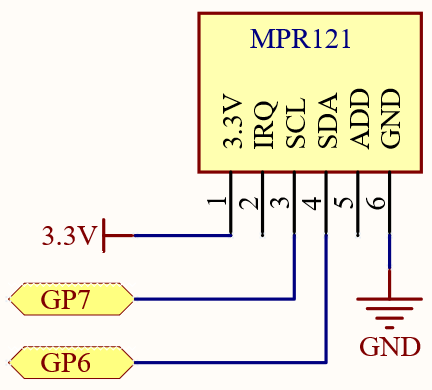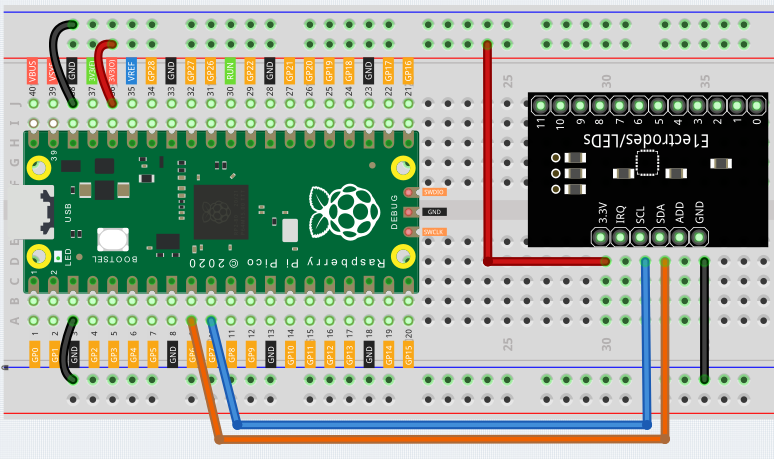4.3 Electrode Keyboard¶
The MPR121 is a good choice when you want to add a large number of touch switches to your project. It has electrodes that can be extended with conductors. If you connect the electrodes to a banana, you can turn the banana into a touch switch.
Schematic

Wiring

Code
Note
Open the
4.3_electrode_keyboard.pyfile under the path ofeuler-kit/micropythonor copy this code into Thonny, then click “Run Current Script” or simply press F5 to run it.Don’t forget to click on the “MicroPython (Raspberry Pi Pico)” interpreter in the bottom right corner.
For detailed tutorials, please refer to Open and Run Code Directly.
Here you need to use the library called
mpr121.py, please check if it has been uploaded to Pico, for a detailed tutorial refer to Upload the Libraries to Pico.
from mpr121 import MPR121
from machine import Pin, I2C
import time
i2c = I2C(1, sda=Pin(6), scl=Pin(7))
mpr = MPR121(i2c)
# check all keys
while True:
value = mpr.get_all_states()
if len(value) != 0:
print(value)
time.sleep_ms(100)
After the program runs, you can touch the twelve electrodes on the MPR121 with your hand and the touched electrodes will be printed out.
You can extend the electrodes to connect other conductors such as fruit, wire, foil, etc. This will give you more ways to trigger these electrodes.
How it works?
In the mpr121 library, we have integrated the functionality into the MPR121 class.
from mpr121 import MPR121
MPR121 is an I2C module that requires a set of I2C pins to be defined to initialize the MPR121 object. At this point the state of the module’s electrodes will be recorded as initial values. If the electrodes are extended, the example needs to be rerun to reset the initial values.
from machine import Pin, I2C
i2c = I2C(1, sda=Pin(6), scl=Pin(7))
mpr = MPR121(i2c)
Then use mpr.get_all_states() to read if the electrodes are triggered. If electrodes 2 and 3 are triggered, the value [2, 3] will be generated.
while True:
value = mpr.get_all_states()
if len(value) ! = 0:
print(value)
time.sleep_ms(100)
You can also use mpr.is_touched(electrode) to detect a specific electrode. When triggered, it returns True, otherwise it returns False.
while True:
value = mpr.is_touched(0)
print(value)
time.sleep_ms(100)